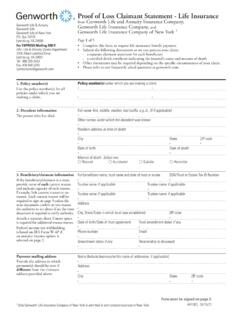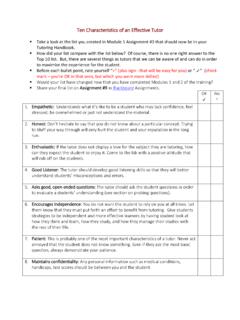Transcription of Genworth Cost of Care Survey
1 131168 12/02/20 Genworth Cost of Care SurveySummary and Methodology1 Genworth Cost of Care Survey , conducted by CareScout , August 2020. Represents the Year over Year growth rate based on Genworth Cost of Care Surveys conducted from 2016 to 2020. This rate can be influenced by a number of factors such as random variation in samples, different sample sizes, and new surveyed impacts us all. Whether we love someone who is growing older, or we ourselves are in our later years, everyone is touched by aging and the cost of care. At Genworth , we honor this experience because we are all someone s daughter or son, husband or wife, coworker, neighbor, or friend. To help families just like ours plan for long term care, in 2004 we created the Genworth Cost of Care Survey , a comprehensive analysis and interactive digital tool to calculate long term care expenses across all 50 the last 17 years, we have continuously seen nationwide increases in the cost of care.
2 2020 is no exception, as unprecedented obstacles, namely the COVID-19 pandemic, coincided with an escalation in other operating expenses for care providers. Pre-pandemic, the rapidly aging population required heightened levels of care at an increasing cost. Amid the pandemic, care providers and facilities are reporting yet another round of rising rates. 2020 saw a considerable increase in the cost of assisted living facilities that offer care in a residential community. Following last year s trend, in-home care is also on the rise. This includes the cost of both homemaker services that is assistance with hands off everyday tasks such as cooking, cleaning, laundry, and providing companionship as well as home health aides who provide hands on assistance with activities like bathing, eating, going to the bathroom, and getting a single year, assisted living facility rates increased by , resulting in an annual national median cost of $51,600 per year.
3 Homemaker services increased by , equating to an annual national median cost of $53,768, closely followed by home health aide services with a increase and an annual national median cost of $54,912. Private room nursing home rates increased by with an annual national median cost of $105,850 along with semi-private nursing home rates escalating by to an annual national median cost of $93,075. Adult day care decreased by with an annual national median cost of $19, response to this year s price escalations, we conducted a follow-up study to understand how COVID-19 is impacting the cost of care. Our research suggests that the following factors are contributing to rate increases: Labor shortages Employee recruitment and retention challenges Personal Protective Equipment (PPE) costs Wage pressures Regulatory changes (including updated CDC guidelines) Supply and demandTo learn more, visit The following information provides a high level overview of the 2020 national median rates for the various types of care settings including changes since the 2019 Survey , the five-year annual growth rate, as well as the methodology used for the of 2020 Survey Findings1 Genworth Cost of Care Survey I SummaryAssisted Living Facility (ALF): Residential arrangements providing personal care and health services.
4 The level of care may not be as extensive as that of a nursing home. Assisted living is often an alternative to a nursing home, or an intermediate level of long term care. Nursing Home Care: These facilities often provide a higher level of supervision and care than Assisted Living Facilities. They offer residents personal care assistance, room and board, supervision, medication, therapies and rehabilitation, and on-site nursing care 24 hours a MEDIAN MONTHLY RATE$4,300 CHANGE SINCE 20196 .15%FIVE-YEAR ANNUAL MEDIANDAILY RATE$255 NATIONAL MEDIANDAILY RATE$290 CHANGE SINCE CHANGE SINCE ANNUAL ANNUAL GROWTH23 .01%Semi-Private RoomPrivate RoomNATIONAL MEDIAN DAILY RATE$74 CHANGE SINCE2019 1. 33%FIVE-YEAR ANNUAL Day Health Care (ADC): Provides social and support services in a community-based, protective setting. Various models are designed to offer socialization, supervision and structured activities.
5 Some programs may provide personal care, transportation, medical management and MEDIAN HOURLY RATE$24 CHANGE SINCE ANNUAL GROWTH23 .71%NATIONAL MEDIAN HOURLY RATE$ SINCE ANNUAL GROWTH2 Services: Services providing help with household tasks that cannot be managed alone. Homemaker services includes hands-off care such as cooking, cleaning and running Health Aide Services: Home health aides offer services to people who need more extensive care. It is hands-on personal care, but not medical care. The rate listed here is the rate charged by a non-Medicare certified, licensed 2 Percentage increase represents the compound annual growth rate for surveys conducted from 2016 to Cost of Care Survey I Summary3 Various provider categories used in the Survey may not be the same as the definitions used in a long term care insurance Not all states require a license for home care.
6 Data includes certain states where unlicensed providers are included because the state does not offer or does not have HH license CareScout has conducted the Genworth Cost of Care Survey annually since 2004. Located in Waltham, Massachusetts, CareScout has specialized in helping families find long term care providers nationwide s i n c e 19 9 7. This year, CareScout a Genworth company contacted 57,981 providers3 to complete 14,326 surveys of nursing homes, assisted living facilities, adult day health facilities and home care providers. Potential respondents were selected randomly from the CareScout nationwide database of providers in each category of long term care services. Survey respondents representing all 50 states and the District of Columbia were contacted by phone during July and August of 2020. Survey respondents were informed that Survey data provided would be included in the Genworth Cost of Care Survey 2020 results.
7 Survey questions varied based on the type of care provider. One of the most comprehensive surveys of its kind, the Genworth Cost of Care Survey publishes costs in 435 regions based on the 384 Metropolitan Statistical Areas (MSAs). MSA definitions are established by the Office of Management and Budget. The Survey also includes some counties outside of the MSA regions. Data collection attempted for all provider types in all regions, the following results in this document represent the number of regions where data collection was successful. Home Care (HC)3 Across 422 regions, surveyors completed 3,981 interviews with licensed home health care providers representing percent of home care The agencies surveyed provided home health care and homemaker services where a skilled nurse does not need to be present. A home health aide will typically help with bathing, dressing, transferring and toileting, but not with catheters or injections.
8 Most of these agencies also provide homemaker services that typically include assistance with shopping, finances, cooking, errands and transportation. Homemaker services may also be employed for the purpose of providing companionship. Annual rates are based on 44 hours of care per week, multiplied by 52 weeks. Where a rate range was provided, the midpoint was used. The Survey excludes holiday rates. Adult Day Health Care (ADH)Across 292 regions, surveyors polled percent of adult day health care facilities, resulting in 870 completed surveys. ADH is designed to meet the needs of adults who are functionally and/or severely cognitively impaired. Programs are intended to be structured and comprehensive, and to take place in a protective setting that promotes well-being through a variety of health, social and other support services.
9 These services are intended to help enable individuals live more independently in the community and may also be used to provide relief for family Cost of Care Survey I MethodologyADH facility rates are structured in a variety of ways: Some charge by the hour, some by the half-day and others for the full day, regardless of utilization. All rates used in Genworth s Survey were extrapolated to a daily (6-8 hours) rate. ADH facility rates may be subsidized by the government or the community. A government subsidy is based on the individual s ability to pay. However, a community subsidy is available to individuals regardless of their income level. This Survey captures the full private pay rates or, where applicable, the community subsidy rates. This Survey does not capture the government subsidy rates are based on the daily rate multiplied by five days per week, then multiplied by 52 weeks.
10 Assisted Living Facilities (ALF)5 Across 427 regions, surveyors polled percent of licensed assisted living facilities, resulting in 6,050 completed surveys. Surveyors also determined whether the facility charges a non-refundable community or entrance fee. This study shows that approximately 59 percent of assisted living facilities charge a one-time, non-refundable fee. Unlike nursing homes, there is no uniform regulatory standard for assisted living facilities. As a consequence, states have instituted licensing standards that vary from state to state. The assisted living facilities polled were licensed according to the licensure requirements of the state in which the assisted living facility was located. Currently, there are more than 70 different names or designations for facilities licensed as some form of an assisted care facility.







